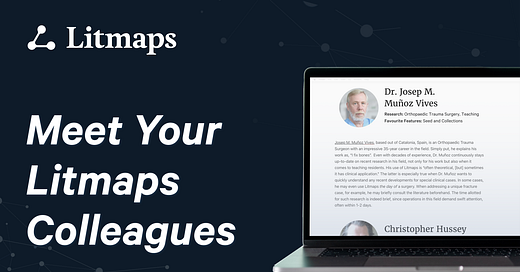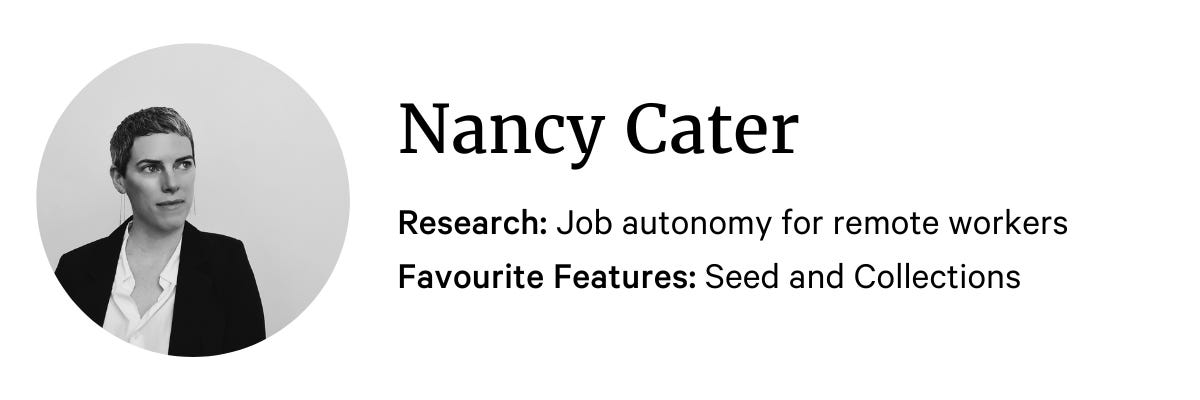Meet Your Unique Colleagues, and a New Research Webinar
When we set out to learn about the different ways researchers use Litmaps, we couldn’t have imagined how astoundingly unique and exciting the answers would be. Plus, we have exciting news!
In the past couple of weeks, I’ve met one-on-one with researchers of various backgrounds who frequently use Litmaps to support their work. I couldn’t have expected just how different and remarkable their uses would be. From checking Litmaps before surgery to finding papers to help build a more sustainable Europe, their use cases blew the whole Litmaps team away. Although no two stories were the same, all of these individuals found our key features, like Seed, Discover, and Maps, critical in getting their impactful work done faster.
Not only do they offer fresh perspectives and ways of applying Litmaps to their problems, but paint a picture of what all our users are collectively doing: tackling important questions and challenges each day to better serve patients, clients and communities.
Before we dive into their responses, we’re excited to announce our own upcoming Litmaps Webinar on Thursday October 12th. I’ll cover how to effectively use Litmaps for your literature review, and preview lesser-known features like Co-Author Search and Maps. I’ll pack in a lot in this one-hour Webinar, and leave time afterwards for questions, so you can get all the help you need. RSVP below.
New: Litmaps Webinar
Thursday October 12th 2023
9 AM London (UTC+1) 7 PM Sydney (UTC+11) 4 AM New York (UTC-4)
Josep M. Muñoz Vives, based out of Catalonia, Spain, is an Orthopaedic Trauma Surgeon with an impressive 35-year career in the field. Simply put, he explains his work as, “I fix bones”. Even with decades of experience, Dr. Muñoz continuously stays up-to-date on recent research in his field, not only for his work but also when it comes to teaching residents. His use of Litmaps is “often theoretical, [but] sometimes it has clinical application.” The latter is especially true when Dr. Muñoz wants to quickly understand any recent developments for special clinical cases. In some cases, he may even use Litmaps the day of a surgery. When addressing a unique fracture case, for example, he may briefly consult the literature beforehand. The time allotted for such research is indeed brief, since operations in this field demand swift attention, often within 1-2 days.
When it comes to teaching, Dr. Muñoz stays up to date on journals and treatments, and uses Litmaps to help prepare lectures. His typical Litmaps workflow involves starting with a Seed Map and adding papers to well-organised Collections that he can later use to discover more papers.
Christopher Hussey, based in Las Vegas, Nevada, is a Commercial Strategist Consultant. He helps municipalities and big companies switch to Zero Emissions by helping them design the technology necessary to get there. In this dynamic role, Chris uses Litmaps to not only review new technologies, but also to analyse and share the historical research behind them. That’s important when an organisation like the Department of Energy (DOE) in the U.S. considers investing millions into a new technology. In these contexts, Chris shares his Litmap of papers in order to help illustrate the history and evidence behind new research, which ”helps them to justify [investment] to investors.”
As exciting as his present day work is, Chris’s background as a former military reconnaissance specialist reminds us of how research used to be. In the past, Chris would conduct research manually at public and military libraries. Now, his entire process is automated using Litmaps and other research tools.
“The whole research process would take months… Now I can do that in an hour.”
He uses Seed Maps to begin exploring a topic and starting finding older, historic papers on his new technology topic. Then, he uses Discover to find all the relevant, historic research (for example, wind turbine research from 1970 to today) and piece together a whole story and timeline, which he then shares with his clients.
Chris uses the whole suite of Litmaps features — including Seed and Discover to find papers, and Maps themselves to give collaborators (and himself) a clear idea of how research has evolved in a field.
Nancy Cater is a graduate student in Organisational and Occupational Psychology at Northumbria University in Northern England. Her research focuses on the relationship between job autonomy and remote work engagement, a big topic coming out of the pandemic. Nancy has found Litmaps to be a valuable resource for conducting literature reviews, particularly for identifying seminal studies in her field. She recalls how she used it at the start of her Master’s thesis:
“I used this [Seed Maps] in the exploratory stage, especially for new papers.”
She would even spot papers that are harder to find in Google Scholar, particularly more recent publications with fewer citations. Over time, Nancy's use of Litmaps has evolved from literature exploration to organisation. She creates Collections of papers related to specific aspects of her research such as gender, age, and employee engagement, to help keep track of the hundreds of papers she’s juggling for her almost-completed thesis.
Pablo Carnero Melero is an engineer and current PhD student, based in Valencia, Spain. Pablo initially turned to Litmaps during his Ph.D. research on the energy performance of residential buildings in Spain. Litmaps helped him unravel the origins of research questions and understand how others had addressed similar topics.
“I come across this piece of research and I want to know more about that. Is this the actual ‘Seed Paper' of the research question or just the one that I found? I want to pull that thread and find out who was the first person who figured out the problem or this subject.”
In addition to his studies, Pablo also works as a European Project Manager, helping Europe in its goal to be energy neutral by focusing on the sustainability of housing. Given the scope of his work, he often looks at what solutions have been attempted and how they may apply in other countries within Europe.
It’s been exciting and humbling to learn how Pablo, Nancy, Chris, and Josep use Litmaps in such a wide variety of research contexts. If you’d like to share your story about how Litmaps is helping your work, please get in touch! We’d love to hear from you, and you may even be featured in a future newsletter like this one.
And, don’t forget to RSVP for the upcoming Webinar if you’re interested to see all the ways you can get more done with Litmaps.









Is the webinar going to be recorded? I would love to see it but a 4AM time does not work for me?
Mott Given